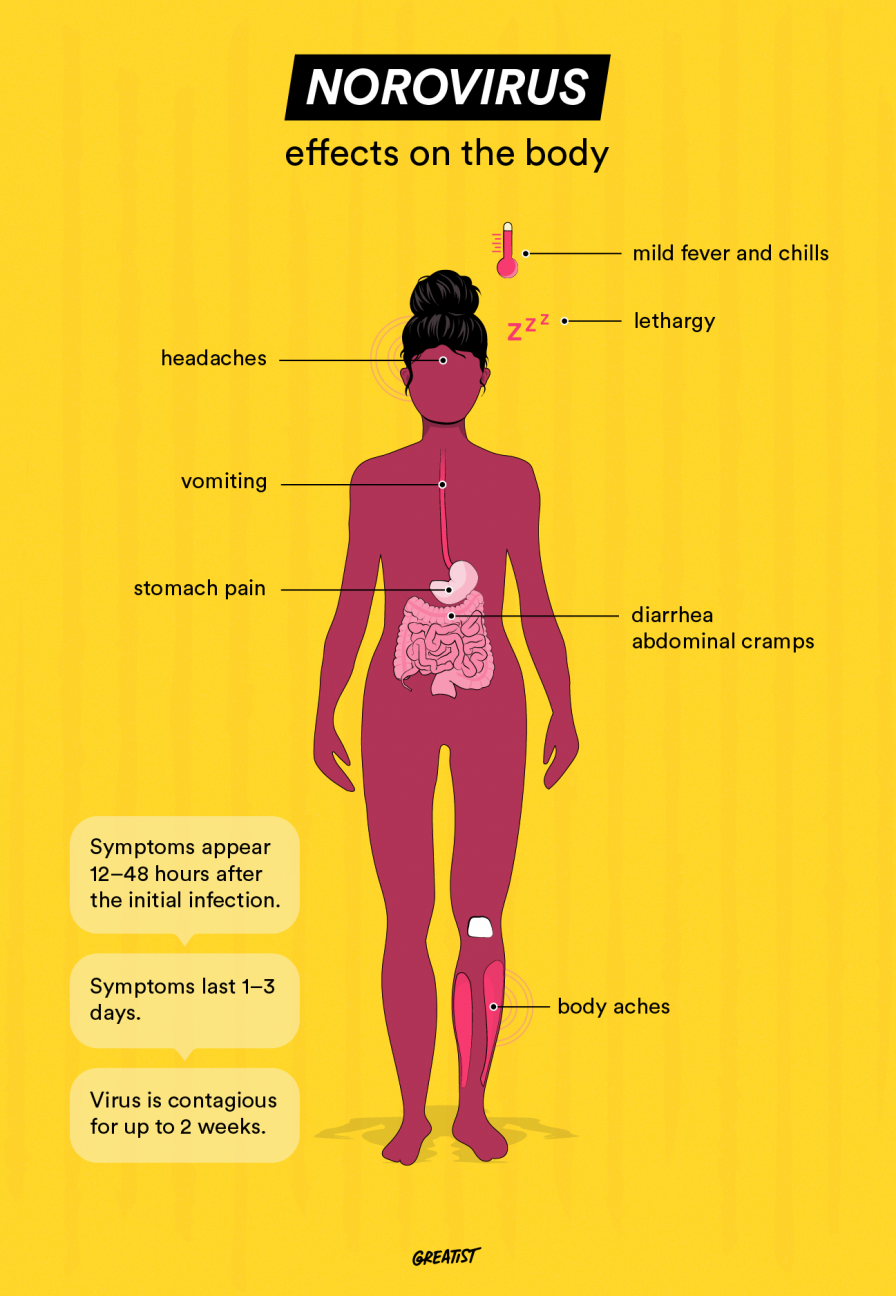If you find yourself stricken with sudden nausea and stomach pain, it could be one of the most common gastrointestinal infections in the world: norovirus. About 1 in 15 people in the United States get norovirus each year.
Here’s what you need to know about what it is and how to deal with its unwelcome occupation of your body.
How does norovirus compare with other stomach “bugs”?
| Symptoms | Incubation period | Duration | Treatment | |
|---|---|---|---|---|
| Norovirus | nausea, vomiting, diarrhea (watery, not bloody), stomach cramps | 12–48 hours | 1–3 days | Drink fluids and rest. |
| Listeria | fever, diarrhea If infection spreads beyond the gastrointestinal system: Stiff neck, confusion, loss of balance, convulsions, fever, muscle aches |
7–70 days | days or weeks | Invasive listeriosis should be treated with antibiotics. |
| Salmonella | diarrhea, fever, stomach cramps, vomiting | 6 hours to 6 days | 4–7 days | Rest and fluids; antibiotics may be prescribed for very ill people. |
| E. coli | severe diarrhea, often bloody; severe stomach pain; vomiting | 1–10 days | 5–10 days | Drink fluids and rest. |
| Clostridium perfringens | diarrhea, stomach cramps | 6–24 hours | up to 24 hours | Drink fluids and rest. |
| Campylobacter | diarrhea (possibly bloody), stomach cramps, fever, vomiting | 2–5 days | 2–10 days | Rest and fluids; antibiotics may be prescribed for very ill people. |

What exactly is norovirus?
Norovirus is one kind of virus that can cause viral gastroenteritis, inflammation of the stomach and intestines. Gastroenteritis is a bout of vomiting and diarrhea that people commonly refer to as a stomach bug, stomach flu, or stomach virus.
About 20 million Americans get sick from norovirus every year, so chances are good you’ve had a run-in or two.
Most people recover from norovirus after a few days, but sometimes it’s serious, especially for children and older adults. It leads to 56,000 to 71,000 hospitalizations and 570 to 800 deaths in the United States each year.
Norovirus is carried in the feces and vomit of people who have the virus. Norovirus is very hard to kill because it survives freezing, hot temps, and some common disinfectants. You can contract it from someone who has it, from consuming contaminated food or water, or from touching a contaminated surface and then touching your mouth.
Symptoms of norovirus

What does it feel like to have norovirus? Not great. These are the main symptoms:
- diarrhea (watery, not bloody)
- vomiting
- nausea
- stomach pain
Adults are more likely to experience diarrhea with a norovirus infection, while children are more likely to experience vomiting.
Other symptoms of norovirus include:
Norovirus remedies
Follow these steps to start feeling better:
- Drink plenty of fluids. All that vomiting and diarrhea can lead to dehydration fast. To avoid hospitalization and intravenous fluids, steadily sip water or other fluids, such as diluted sports drinks or diluted juice. The best hydration for small children who are sick is a commercially available pediatric electrolyte solution like Pedialyte.
- Rest. Please don’t be a hero. Norovirus earns you the right — nay, the obligation! — to stay in bed until you feel better. Your family and co-workers will thank you for reducing their exposure to the highly contagious virus.
- Keep it clean. Yes, you feel like garbage, but it’s still important to wash your hands and disinfect areas where you’ve been sick to stop spreading the virus. Remind anyone in your space to be liberal with hand soap and cleaning sprays too.
- Eat. You should eat once you feel up to it. Follow your appetite. Avoiding food will not help you recover faster.
- Call the doctor. If you’re not getting better after a day or two and you haven’t been able to drink much, dehydration is a real risk. Contact a medical professional for advice on what to do next.
Who’s most likely to catch norovirus?
Norovirus is common, and most people have a case in their lifetime. Because norovirus spreads so easily, outbreaks tend to happen in places where groups of people are in close contact, like nursing homes, schools, the military, sports teams, and cruise ships.
Getting norovirus once doesn’t protect you from contracting it again in the future. Because the virus changes frequently, you’re susceptible to infection again and again.
What causes a norovirus infection?
The virus lives in the feces and vomit of people who have contracted it. Gross, but that’s life. If you have contact with someone who has the virus, it can enter your body.
Beverages and food may be contaminated if handled by someone who has norovirus. This can be a serious concern in food service, because one person could transmit the virus to food that many, many people eat.
People who are carrying the virus may also pass it to surfaces they touch. If you touch one of those surfaces (like a doorknob, a light switch, a handrail, or literally anything in a bathroom) and then touch your mouth without washing your hands first, you could contract norovirus.
Remember, this is a tough little virus! According to the Centers for Disease Control and Prevention (CDC), norovirus can survive on food even if it’s frozen or heated to 140°F. It can live on counters and utensils for up to 2 weeks and is resistant to some disinfectants and hand sanitizers.
Headed for an outbreak
Norovirus is sometimes called the “winter bug” because outbreaks occur more often from November to April. Still, you can come down with norovirus any time of the year.
We’ve discussed how persistent norovirus is, able to survive extreme temps and cleaning efforts. On top of that, even a very tiny amount of the virus (10 to 100 viral particles) can cause an infection. When you take an invincible germ and make it highly contagious, the risk for outbreaks — rapid spread in communities — is high.
When you vomit, virus particles are dispersed in the air and land on surfaces around you, creating potential for others to contract the virus. And people may continue to shed the virus up to 2 weeks after they feel better. In communities or households where people live and work together, it’s very hard to contain the spread of norovirus.
So, what can you do?
Follow these tips to reduce your chance of norovirus infection:
- Wash your hands. You know the drill by now — wash with soap and water for at least 20 seconds after you use the bathroom and before, during, and after making or eating food.
- Clean surfaces where someone has vomited or had diarrhea with a bleach-based cleaner. Disinfect food preparation areas often.
- Wash fresh produce and cook shellfish thoroughly (undercooked shellfish is a commonly contaminated food).
- Don’t prepare or serve food to anyone while you’re sick with vomiting or diarrhea or for a few days after you feel better.
- Wash fabrics soiled by vomit or diarrhea immediately in hot water and dry on high heat.
- Isolate a sick member of your household if possible.
- Wear a mask and gloves when cleaning up or caring for a sick family member.
It might get complicated
Most people recover from norovirus after a day or two if they stay hydrated. Dehydration can happen fast, and children and older adults are especially vulnerable. If someone with norovirus is unable to drink fluids, becomes lethargic, or has dry lips and eyes, they may be dehydrated.
In some cases, dehydration must be treated with intravenous fluids in a hospital. Call or visit a doctor immediately if you or a family member shows signs of dehydration.
tl;dr
Norovirus causes gastrointestinal inflammation in millions of people every year. It’s a stubborn little virus, easy to spread and hard to kill. Fortunately, most people recover after a few days of vomiting or diarrhea.
Take precautions to prevent spreading norovirus to others, and call a doctor if you can’t drink fluids and become dehydrated.

0 Commentaires